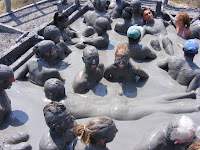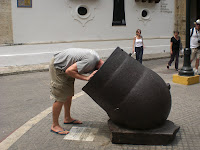
'Isn't it great, we are all on holiday every day for such a long time', commented a Dutch couple, whilst we shared a volcanic mud bath in the swamps of Colombia and discussed long term traveling itineraries. I was finding it hard to concentrate due to the butt naked German man dive bombing into the mud inches from my face, and so agreed with the Dutchies enthusiastically. But later I realized that they had pin pointed exactly what we have been struggling with. Being on holiday all day every day for such a long time is mentally exhausting.

For Nick and I it feels completely unnatural. Work has always been the predecessor of fun – eat all your veg and you can go out and play, finish an essay and you can hit the town, complete a project and enjoy a long weekend of festival frolicking. Evenings, weekends and holidays are great because they are a break from the norm. But what's great when the norm is holidaying? Well... work. Hence the thousands of wannabe travel writers, volunteers, English teachers, eco-farmers and language learners frantically seeking a purpose as they gallavant around the world. We too fall victim to the quest for work.

Luckily we are now pretty good at overcoming this crisis. So with a week to kill in the beautifully rustic colonial city of Cartegena, and a recognition on day two that we can't afford to frolic in the fine restaurants and on day tours with all the holidayers, Nick and I devise a plan. First we decide to teach ourselves Spanish for 3 hours a day. This goes surprisingly well considering my language associated disability, our competitive tendencies and differing approaches to getting things done. By day three we had picked up most of the basics and set about putting them into practice. Communication is still a slight struggle (Nick often refers to me as his boyfriend and I asked a women how much it would be to wash England at a phone booth yesterday), but we're getting there. Second, we get down

to some serious planning of the rest of the trip. Before leaving London we drew a nice long line around the world, saved as many pennies as possible and researched the key components to check our route was possible. There are therefore quite a few details to fill in as we go along. This is great because planning the trip is an exhilarating, empowering and evolving process that provides many of the challenges of a real job but is just loads more fun. Problem solved.

Asia is the topic of the moment. An awesome and overwhelmingly huge landmass filled with the highest, remotest, coldest, wildest, newest and oldest places in the world. The very thought of crossing it overland sends tingles down my spine. Our original plan was a rather ambitious tour of China, India, South East Asia, Mongolia, Russia and all the 'stans. However, as the trip goes on, spending longer in a few places

becomes more appealing than gaining huge numbers of stamps in passports. Nick finds well paid, short term teaching posts in Japan and so we start the application process. By question three it became clear that we are better equipped to lecture on the elaborate mating dances of the lesser spotted quetzal than teach in these Universities. So before starting to seek less high brow teaching posts we then start to question the whole teaching in Japan experience.

'Why don't we go and do something a bit messier and rawer. Lets go somewhere random for the winter... How about charity work in Mongolia?' I suggest enthusiastically, picturing us trekking through snow on horse back through nomadic lands doing something terribly noble and hard going.
'Er I think it might be a bit cold, but yeh that sounds more interesting, lets look into it'. Nick suggests, always the necessarily rational after thought to my excitable ideas.
So we set about researching Asia. Mongolia in December, January and Febuary is -30°C. Hard going? Yes. Noble? Tricky when you can't go outside without wearing a yak.

And so the researching continues, where to go, when you can go there, what visas you need and how to get there. Discussions take place to a back drop of latino beats in bohemian squares, on church steps, park benches and beach towels, sipping from shots of coffee or rum. We even ended up watching a Bavarian film based in Central Asia at the Cartegena film festival. A random coincidence given that we only chose the film because its title, Absurdistan, implied that the language barrier wasn´t going to be too detrimental. It was brilliant and beautiful and had English subtitles. I came out enthusiastically declaring that this is a sign that we should herd sheep in Azerbaijan for a year. Nick pointed out that Georgia might not be the best country to travel through at the moment. But we'll see... a lot can change in a year.
Tomorrow we join Captain Hernando and ten other globe trotters to sail to Panama via the San Blas Islands, home to the indigenous Kuna tribe, paradise beaches and lots of fish. To mix it all up a little we´re planning on taking along a rather large bottle of rum.
 190 days away. As the cliché goes, it seems like an age since we cycled out of Hyde Park, but also just the other day we bid goodbye to family and friends. Looking back at what we have done so far it seems like a huge amount of ground covered, but tomorrow two friends are flying out and getting here from London in just 12 hours.
190 days away. As the cliché goes, it seems like an age since we cycled out of Hyde Park, but also just the other day we bid goodbye to family and friends. Looking back at what we have done so far it seems like a huge amount of ground covered, but tomorrow two friends are flying out and getting here from London in just 12 hours.

Slowest transport: Lista Light, 0.5knots becalmed off the Sahara












